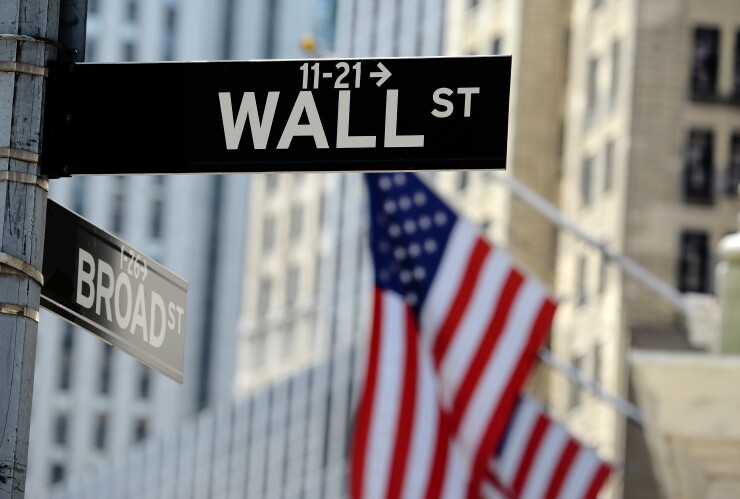Investors are continuing to sour on bank stocks as the industry prepares its earnings reports for the first quarter — a volatile period that featured the second-largest bank failure in U.S. history.
The fears appear to be a bit less panic-driven than they were last month, when Silicon Valley Bank's quick collapse spooked investors over whether a handful of regional banks could suffer a similar fate. Signs of those worries are still evident, analysts say, but markets are reflecting a broader concern that many banks' best days of profits are behind them, at least for a little while.
"I think that you're going to continue seeing caution," said David Smith, a bank analyst at Autonomous Research.
The KBW Nasdaq Bank Index benchmark fell about 0.5% on Wednesday, though several banks saw slightly bigger declines. Others whose stock
Western Alliance Bancorp in Arizona fell more than 12%. Investors
The larger drops reflect some lingering worries from some investors over the health of a few banks. But broadly, investor concerns have turned less existential and more focused on bread-and-butter issues — not whether more banks will fail, but how much money they'll make in the coming months.
"There's a sentiment that we're through the worst of it at this point, although there are still some banks with big question marks," Smith said.
Concerns among investors include: How much will banks' borrowing drive up their expenses? Will they need to pay their depositors more to avoid outflows? Will a potential recession prompt a decrease in bank lending? And how will their loans hold up in a downturn, particularly if they have
For some big-name investors, those questions and overall uncertainty make banks a "no-go zone," said Jeff Davis, managing director at the financial advisory firm Mercer Capital. "There's not a strong desire to own the stocks among the generalist institutional investor at all," Davis said.
There is "a lot of selling pressure that hasn't abated yet," he said, as institutional investors' pullback coincides with worries over higher interest expenses at banks and the health of their loan books.
Analysts and investors are anxiously awaiting details on banks' deposits. Some banks like Western Alliance have released deposit numbers to try to soothe investor concerns, and aggregate data from the Federal Reserve
But the full details will come starting April 14, as banks kick off the quarterly earnings season and their CEOs take public questions from analysts for the first time since SVB's failure.
Regional banks may see some short-term rallies in their stocks "if deposit outflows are not as bad as feared," Manan Gosalia, an analyst at Morgan Stanley, wrote in a note to clients. But Gosalia cautioned against buying into that narrative given rougher prospects for the industry as a whole.
"We recommend fading any rally," Gosalia wrote. "The medium-term outlook is tough for every driver of midcap bank returns — cost of funds, loan growth, fees, expenses, provisions and capital."
At Western Alliance, President and CEO Kenneth Vecchione touted the bank's "uniquely flexible, diversified business model" in a quarter-end update after markets closed on Tuesday.
"Put simply, Western Alliance Bank is different; this diversification continues to distinguish us from monoline or sector-concentrated peer banks," Vecchione said in a news release, which included several data points aimed at reassuring investors.
But Tuesday's update raised "more questions than answers," Jefferies analyst Casey Haire wrote in a note to clients. While it included some data points, the "most important one" was missing as the company opted against giving firm details on where its deposits stood, Haire noted.
The bank released another update on Wednesday afternoon, saying it ended the quarter with $47.6 billion in deposits, down from $53.6 billion at the end of 2022. The outflows came just after the failures of SVB and Signature Bank, and balances "stabilized" and began growing after March 20, the company said.
The growth has continued since the quarter ended on March 31, the company said, noting it has added some $1.2 billion in deposits so far this quarter. It also noted that its insured deposits are now about 68% of its total deposits, significantly above year-end levels.
The stock failed to rebound after the investor update, though several analysts who cover Western Alliance viewed the update positively. The overall deposit decline is large, but it is "ultimately an acceptable and manageable outcome for the company," wrote Jon Arfstrom, an analyst at RBC Capital Markets.
"We greatly appreciate today's update and the transparency on the deposit trends, and we believe the increased clarity on balances should be very helpful to the Street and investors," Arfstrom wrote in a note to clients.
The deposit situation is "better than feared," Brandon King, an analyst at Truist Securities, wrote in a note to clients. "While earnings are under material near-term pressure, we think the stabilization of deposit pressures should allay investor concerns of severe deposit outflows," King wrote, adding that investors appear to be "pricing in a worst case scenario."







